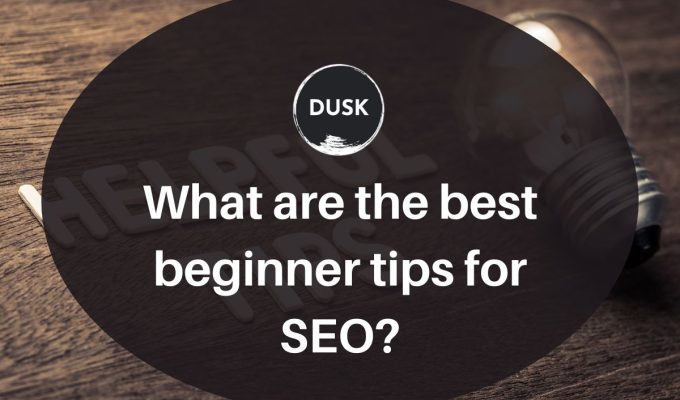Search Engine Optimization (SEO) is a valuable tool for all online businesses and content creators. It’s the practice of optimizing your website to maximize organic traffic from search engines, particularly Google, which dominates the search engine market.
SEO can seem daunting to a beginner, but the key lies in understanding and gradually building on the fundamentals. Here are some of the best beginner tips to get you started with SEO.
Understand the Basics of SEO
First and foremost, you need to understand what SEO is and why it matters. SEO is a set of strategies and tactics to increase a website’s visibility on search engine results pages (SERPs). This involves optimizing your content and website design to make it more attractive to search engines.

Search engines are used by people when they have a query and are searching on the internet for the answer. Search engine algorithms are computer programs that look for clues to give searchers the exact results they are looking for.
Search engines rely on algorithms to find web pages and decide which ones to rank for any given keyword. There are three steps to how search engines work: crawling, which is the discovery stage; indexing, which is the filing stage; and ranking, which is the retrieval stage.
Keyword Research
Keyword research is a cornerstone of any successful SEO strategy. It involves identifying the words and phrases people use in search engines when looking for information, products, or services related to your website or business. These words and phrases, known as keywords, are then used to optimize your content and make it more visible to search engines.
Here are some steps to conduct effective keyword research:
- Understand Your Niche
- Brainstorm Seed Keywords
- Use Keyword Research Tools
- Look for Long-Tail Keywords
- Analyze the Competition
- Understand Keyword Metrics
- Refine and Repeat
Keyword research is about understanding your potential customers’ language when thinking about your products or services and strategically incorporating those words and phrases into your website to attract relevant traffic.
Photo by Caio: https://www.pexels.com/photo/macbook-air-on-grey-wooden-table-67112/
Create Quality Content
Once you’ve identified your keywords, the next step is creating high-quality, valuable content around those keywords. This content can take many forms, including blog posts, articles, videos, and infographics.
Creating quality content is one of the most effective SEO strategies and is vital for driving traffic, engaging visitors, and converting them into customers or followers. Quality content not only appeals to your audience but also to search engines.
Here’s how to create high-quality content:
- Understand Your Audience
- Use Your Keywords
- Create Valuable Content
- Make Your Content Engaging
- Structure Your Content
- Optimize Your Images
- Regularly Update Your Content
- Promote Your Content
Remember, creating quality content is not about a one-size-fits-all approach. What works for one audience or industry might not work for another. The key is understanding your audience, experimenting with different content types and strategies, and continuously learning and adapting.
On-Page SEO
On-page SEO refers to the process of optimizing individual web pages in order to rank higher and attract more relevant traffic in search engines. It involves both the content on the page and the HTML source code.

Here are some key factors for on-page SEO:
- Title Tags: These tell search engines what the page is about and should include your focus keyword.
- Meta Descriptions: These summaries appear in search engine results and should be compelling, include your focus keyword, and be concise.
- Headers: These structure your content and make it easier for search engines to understand. They should include your main keyword.
- Keyword Frequency and Density: Including keywords in your content is crucial, but avoid overdoing it to prevent penalties.
- Image Optimization: Images should have relevant file names, be reduced in size to improve page load speed, and have alt tags.
- URL Structure: URLs should be SEO-friendly, straightforward, and include your main keyword.
- Internal Linking: This helps search engines understand your site’s structure and keeps users on your site longer.
- Mobile-Friendly Design: As more people use mobile devices to access the web, having a mobile-friendly design improves user experience and positively affects SEO.
- Page Speed: Faster page loading is a ranking factor in Google’s algorithm.
- Content Quality: The quality of your content is crucial; it should be original, valuable, engaging, and meet your audience’s needs.
Overall, on-page SEO is a vital part of SEO, and optimizing each page of your website improves your chances of being found by search engines and attracting relevant traffic.
Off-Page SEO
Off-page SEO refers to all your activities outside of your website to improve your website’s ranking in Search Engine Results Pages (SERPs). It primarily involves improving your website’s perception by users and search engines regarding relevance, trustworthiness, popularity, and authority.
Other reputable online places (pages, sites, people, etc.) often accomplish this by linking to or promoting your website. Here are some key factors to consider for off-page SEO:
- Backlinks: Creating backlinks, or links from other websites to your own, is a key element of off-page SEO. Strategies to build backlinks include guest blogging, creating infographics, and producing high-quality content.
- Social Media Marketing: While not a direct ranking factor, a strong presence can increase brand awareness, generate website traffic, and potentially lead to more backlinks.
- Guest Blogging: Contributing high-quality posts to other blogs in your niche can increase exposure and build backlinks, with the focus being on providing value to a new audience.
- Influencer Outreach: Building relationships with influencers in your niche can amplify your content, increasing traffic and backlinks.
- Brand Mentions: Even without a link, brand mentions can contribute to off-page SEO, as Google views them as an indication of brand authority and popularity.
- Forums and Online Communities: Active participation in relevant forums and communities can increase brand visibility and generate website traffic, provided the focus is on providing value rather than self-promotion.
- Reviews and Ratings: Positive reviews and ratings can significantly impact your SEO by enhancing your brand’s reputation and leading to more clicks from the SERPs.
Off-page SEO requires time and patience, primarily building relationships and creating content others want to link to and share. While it may take some time to see the results, the long-term benefits are well worth the effort.
Technical SEO
Technical SEO refers to optimizing your website and server that helps search engine spiders crawl and index your site more effectively. It’s called “technical” because it involves more than just content. It ensures that your website has a solid technical foundation and can greatly affect your rankings in search engines.
Here are some key components of technical SEO:
- Website Crawlability
- XML Sitemap
- Robots.txt File
- Site Speed
- Mobile-Friendly Design
- HTTPS (SSL)
- Structured Data
- Duplicate Content
- Error Pages (404s)
- Website Architecture
While technical SEO might seem daunting initially, especially to those less tech-savvy, it’s a crucial part of SEO. Your site’s SEO performance can greatly improve with a strong technical foundation.
User Experience
User Experience (UX) in SEO refers to optimizing the overall user experience when interacting with a website. Google considers UX a critical ranking factor because a positive user experience leads to higher user engagement, which in turn sends positive signals to search engines about the quality of your site.
Here are some of the main aspects of UX that you should focus on for SEO:
- Website Navigation
- Mobile-Friendly Design
- Page Load Speed
- Content Readability
- User Interface (UI) Design
- Interactivity
- Accessibility
- Error Handling
It is important to note that a positive user experience can lead to higher user engagement, more shares, more links, and ultimately better rankings in search engines. So, investing time in improving the UX of your website can pay off in terms of SEO.
There You Have It!
Getting started with SEO can be a bit overwhelming. Still, by understanding and implementing these basic principles, you’ll be well on your way to improving your site’s visibility and driving more organic traffic.
Remember, SEO is a long-term game. Seeing results takes time and consistent effort, but the payoff can be significant. Don’t be afraid to experiment, learn from your mistakes, and continually refine your strategy. SEO is an ongoing learning, implementing, analyzing, and improving process.
Now that you know the basics of SEO, you may start your digital marketing effort by getting a website first. You’ll want to set up the basic pages, such as the home page, about us, contact us, etc. They don’t have to be “fancy,” but you’ll want them there. Obviously, the more website traffic you get, the better.
You can find affordable and FREE website builders online. Check out WordPress, Weebly, and Wix.






